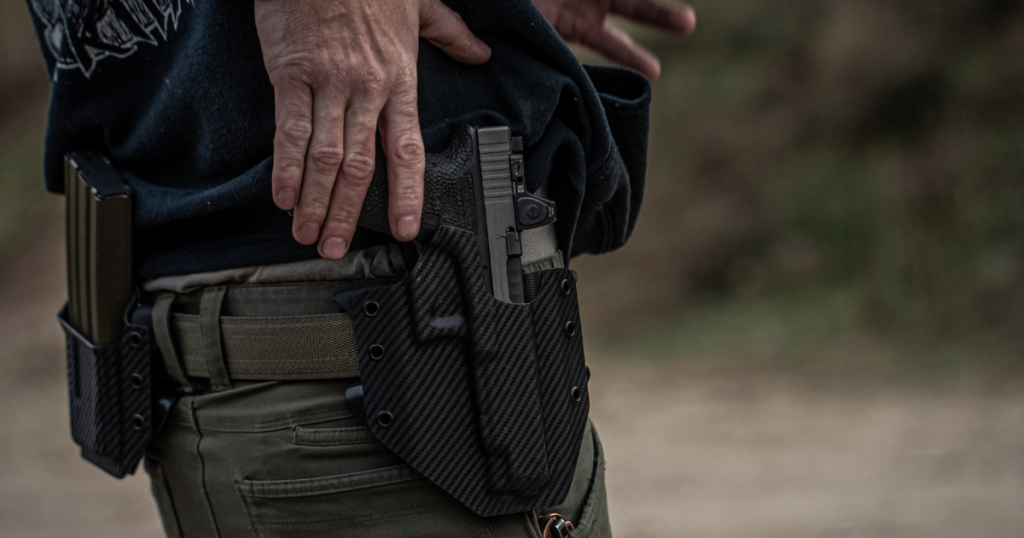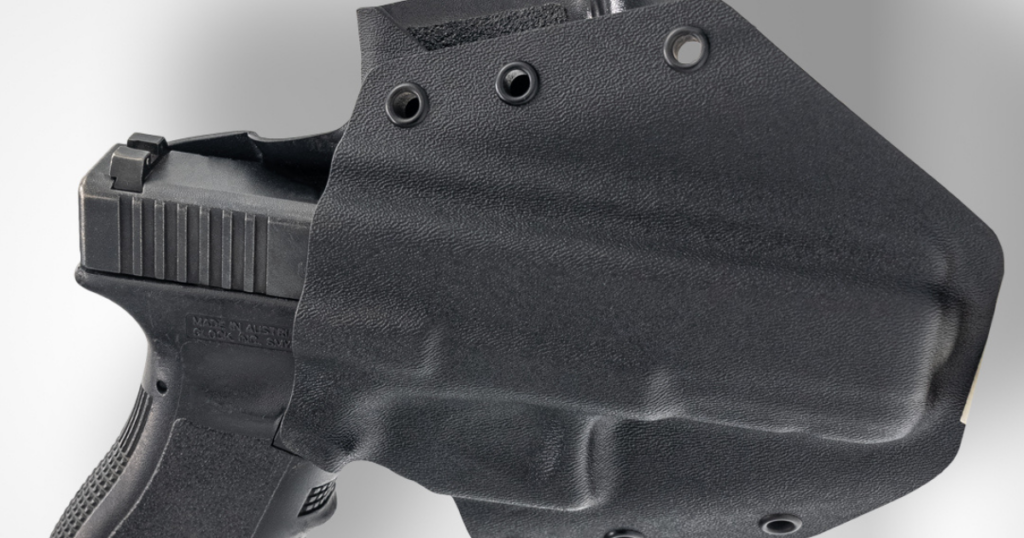Choosing the right method and position for concealed carry makes all the difference in comfort, accessibility, and concealment. OWB (Outside the Waistband) holsters are a popular choice for many carriers, offering the benefits of comfort and quick access. However, to successfully conceal an OWB holster, finding the right carry position and holster style is essential.
What is an OWB holster?
An OWB (Outside the Waistband) holster is designed to carry a firearm on the outside of your pants, usually attached to your belt.
Unlike IWB (Inside the Waistband) holsters, OWB holsters offer more comfort for all-day wear because the firearm rests outside your clothing. This setup provides quick access to your weapon, especially when speed is critical.
Can you conceal carry with an outside-the-waistband holster?
Yes, you can conceal carry with an OWB holster. But it does take some extra consideration compared to IWB.
The key is finding the right position on your body and using the proper clothing to keep your firearm hidden. With the right setup, OWB can be just as effective for concealed carry as IWB.
Factors For Choosing an OWB Concealed Carry Position
Selecting the best concealed carry position involves balancing several factors for concealment and comfort.
Clothing and Body Type
The effectiveness of outside-the-waistband concealed carry largely depends on your clothing choices and body type.
- Clothing: Loose-fitting clothes are generally more effective at concealing firearms carried OWB. Opt for jackets, untucked shirts, or tailored garments that drape naturally to avoid printing (where the outline of the gun is visible).
- Body type: For individuals with a slimmer build, additional layering can help achieve better concealment without sacrificing style. Those with a larger frame may find that their body shape naturally aids in concealment, allowing for a broader range of clothing options.
Accessibility and Comfort
Daily activities heavily influence the best OWB concealed carry position, so consider how your routine impacts your carry position.
Whether you’re sitting for long periods, engaging in physical activities, or moving through different environments, accessibility and comfort should remain top priorities.
Concealment
To maximize concealment with outside-the-waistband holsters, focus on the holster’s placement and design.
- Holster position: Positioning the holster at strategic angles, such as the 3 o’clock or 4 o’clock positions, can increase concealment and ease of draw.
- Holster design: Consider the holster’s cant and fit according to your body type and clothing. Additionally, practicing your draw in different outfits and positions will help you identify any potential issues with concealment or access.
Popular Outside-the-Waistband Concealed Carry Positions

For OWB concealed carry, the best position for you depends on various factors, including your lifestyle, body type, and daily activities. Everyone’s preferences are different, so finding the right position for you will involve a bit of experimentation. The key is balancing comfort, concealment, and accessibility.
(Note: We often use the hours on a clock as a reference to describe carry positions. Imagine standing on a clock face with your belly button pointing to 12 o’clock, your back at 6 o’clock, and your hips at 3 and 9 o’clock.)
Here are the four most common outside-the-waistband concealed carry positions.
On the Hip
This is a natural draw position where the holster is placed directly on the hip, at the 3 o’clock position for right-handed carriers and 9 o’clock for left-handed. It allows for easy access and a quick draw while standing, making it one of the most popular choices for OWB carry.
- Pros: Quick and intuitive access, especially if you need to draw while standing. Suitable for those who prefer simplicity and direct access.
- Cons: Can be less comfortable when sitting for extended periods, like during long drives or at a desk.
Behind the Hip
The holster is positioned slightly behind the hip (4 o’clock right side and 8 o’clock left side), balancing concealment and accessibility. This placement is more comfortable for sitting and offers better concealment under casual clothing.
- Pros: The position is less likely to print and remains comfortable during activities like sitting or driving.
- Cons: Slower draw speed compared to the on-the-hip position.
Kidney Carry
This position is further behind the hip, near the kidneys (5 o’clock right side, 7 o’clock left side), offering better concealment for larger firearms. It’s ideal for carriers who prefer to keep their firearms more hidden, especially under longer coats or untucked shirts.
- Pros: Offers increased concealment for larger firearms, with the back’s natural curvature aiding in disguise.
- Cons: More challenging to draw from quickly and can be uncomfortable during extended periods of sitting.
Small of the Back
In this position, the holster is placed directly over the spine in the small of the back (6 o’clock). It offers high concealment but comes with trade-offs in terms of comfort and ease of access.
- Pros: Highly effective concealment since the firearm is tucked away and less likely to print.
- Cons: Can be uncomfortable when sitting or against car seats, and drawing from this position can be awkward and slow since you need both hands. It also carries a higher risk of injury to your spine if you fall backward.
Choosing an OWB Holster for Concealed Carry
While outside-the-waistband holsters are known for their comfort (especially during extended wear), the challenge lies in keeping your firearm concealed without sacrificing quick access.
Consider the following factors when choosing an OWB holster:
- Retention and security: A firearm needs to stay secure while you’re moving – whether you’re sitting, walking, or running.
- Comfort: The key is finding a holster that contours to your body and won’t dig into your side during long periods of wear.
- Concealment: To reduce printing, look for holsters that sit close to the body and have a forward cant or a contoured design that pulls the firearm in tight.
- Material and durability: A good OWB holster needs to be rugged enough for daily wear but comfortable enough for extended use. Kydex, leather, and polymer blends are common choices due to their durability and resistance to wear.
How the Ronin OWB Holster Excels for Concealed Carry

Our Ronin OWB Holster combines security, comfort, and durability in one package – making it a top choice for concealed carry.
- The Ronin’s positive retention keeps your firearm secure during any activity. No snaps or straps, so you can draw instantly when needed.
- The lightweight, ergonomic design contours to your body for all-day comfort without digging.
- The Ronin’s is designed with a forward cant and contoured belt loops that help balance the pistol’s weight and pull it close to the body.
- Made from rugged Kydex, the Ronin is durable enough for daily use. It resists wear while maintaining comfort and reliability.
For more help choosing a holster, read:
- What to Look For in a Concealable OWB Holster
- How the Right Holster Can Change Your Shooting Experience
- Ronin vs Sentinel vs OWB Holsters
How long should I test an outside-the-waistband concealed carry setup?
When testing an OWB setup, it’s important to remember that it takes time to get used to a new carry system. Even the best OWB holster for concealed carry can feel awkward or uncomfortable initially, especially if you’re used to a different carrying method.
A good rule of thumb is to test your setup for at least one to two weeks. During this time, wear the holster in different environments – while sitting, standing, walking, and driving – to see how it performs under various conditions.
Pay attention to how the holster feels throughout the day, how easily you can access your firearm, and whether it stays properly concealed under your clothing. It’s also helpful to practice drawing your firearm regularly during this test period to check that the holster’s retention and positioning work for you.
Even if you’ve found the best concealed carry position, you may need time to fine-tune your setup. Adjusting the holster’s fit or experimenting with different clothing options can help with comfort and concealment.
Finding Your Perfect OWB Carry Setup
Whether you prefer carrying on the hip, behind the hip, or even in the small of your back, the right holster and position will help you stay prepared while maintaining discretion.
Explore our full range of holsters at GunfightersINC to find the perfect match for your carrying needs.
October 17, 2024
